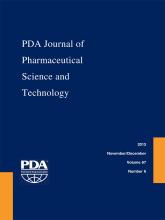Abstract
In the last few years, several quality by design (QbD) studies demonstrated the benefit of systematic approaches for biopharmaceutical development. However, only very few studies identified biosimilars as a special case of product development. The targeted quality profile of biosimilars is strictly defined by the originator's product characteristic. Moreover, the major source of prior knowledge is the experience with the originator product itself. Processing this information in biosimilar development has a major effect on risk management and process development strategies.
The main objective of this contribution is to demonstrate how risk management can facilitate the implementation of QbD in early-stage product development with special emphasis on fitting the reported approaches to biosimilars. Risk assessments were highlighted as important tools to integrate prior knowledge in biosimilar development. The risk assessment process as suggested by the International Conference on Harmonization (ICH Q9) was reviewed and three elements were identified to play a key role in targeted risk assessment approaches: proper understanding of target linkage, risk assessment tool compliance, and criticality threshold value. Adjusting these steps to biosimilar applications helped to address some unique challenges of these products such as a strictly defined quality profile or a lack of process knowledge. This contribution demonstrates the need for tailored risk management approaches for the risk-based development of biosimilars and provides novel tools for the integration of additional knowledge available for these products.
LAY ABSTRACT: The pharmaceutical industry is facing challenges such as profit loss and price competition. Companies are forced to rationalize business models and to cut costs in development as well as manufacturing. These trends recently hinder the implementation of any concepts that do not offer certain financial benefit or promise a long return of investment. Quality by design (QbD) is a concept that is currently struggling for more acceptance from the side of the pharmaceutical industry. To achieve this, the major goals of QbD have to be revisited and QbD tools have to be subsequently developed.
This contribution offers an example as to how implement risk management in early-stage biosimilar development as part of the QbD concept. The main goal was to go beyond the conventional QbD workflow and to adjust risk management to the challenges of biosimilar products. Accordingly, instead of using methods like failure mode and effects analysis, recommendations of the ICH Q9 guideline were reviewed and put into practice by creating tailored risk assessment tools. The novelty of this contribution is to report those tailored tools ready-to-use for early bioprocess development of biosimilars along QbD principles.
- © PDA, Inc. 2013
PDA members receive access to all articles published in the current year and previous volume year. Institutional subscribers received access to all content. Log in below to receive access to this article if you are either of these.
If you are neither or you are a PDA member trying to access an article outside of your membership license, then you must purchase access to this article (below). If you do not have a username or password for JPST, you will be required to create an account prior to purchasing.
Full issue PDFs are for PDA members only.
Note to pda.org users
The PDA and PDA bookstore websites (www.pda.org and www.pda.org/bookstore) are separate websites from the PDA JPST website. When you first join PDA, your initial UserID and Password are sent to HighWirePress to create your PDA JPST account. Subsequent UserrID and Password changes required at the PDA websites will not pass on to PDA JPST and vice versa. If you forget your PDA JPST UserID and/or Password, you can request help to retrieve UserID and reset Password below.






